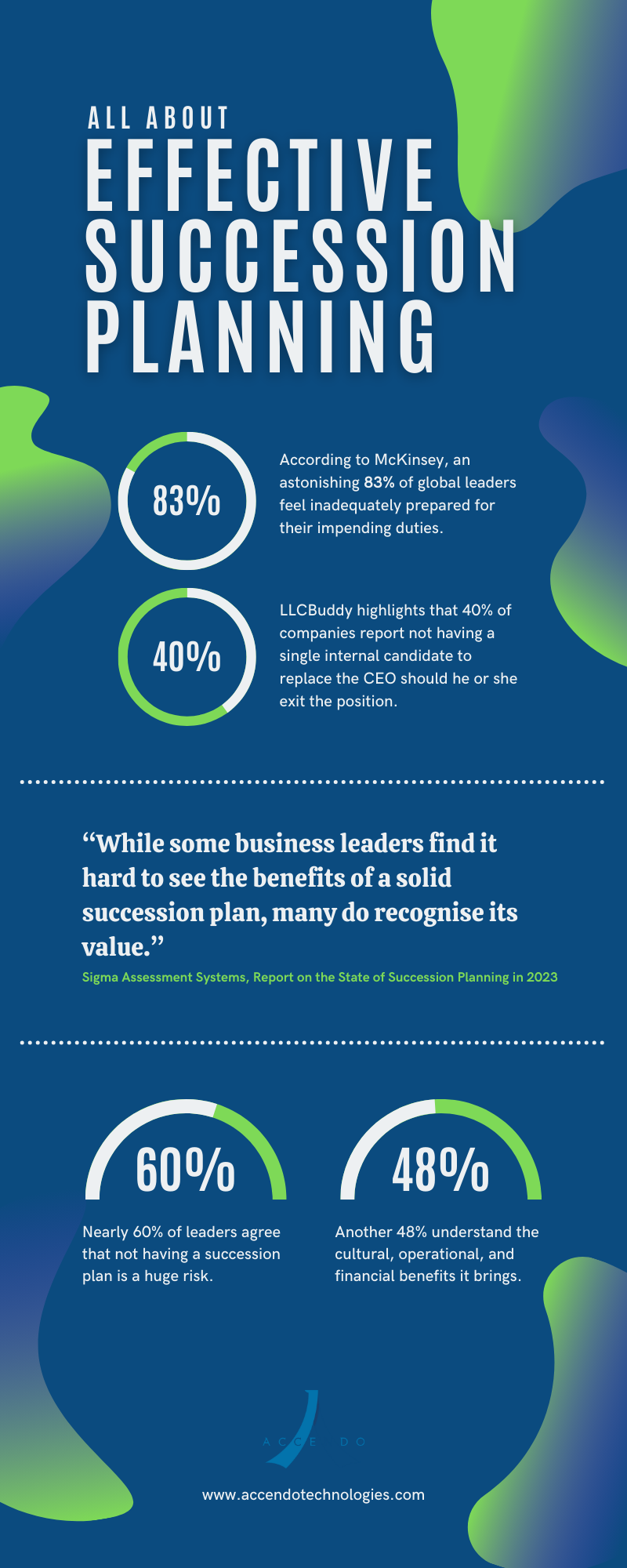Succession planning is the safety net that ensures your business can handle changes smoothly. Smart leaders understand that employee turnover is inevitable, and top performers might eventually move on for several reasons. Rather than seeing this as a negative, with the right planning, effective people management, and open communication, your succession plan can strengthen your company as you adapt to these changes.
Key Takeaways
- Provide a guide on effective succession planning.
- Explain its importance, the challenges faced, and best practices for successful implementation.
Succession Planning vs. Replacement Hiring
You have heard the saying, “If you fail to plan, you plan to fail.” It is easy to overlook future challenges when things are going smoothly. But you never know when a key leader might leave.
That is where succession planning comes in. Many clients we talk to struggle with keeping their leadership team dynamic because they rely on replacement hiring. They wait for change to happen and then scramble. By then, it is too late as their internal candidates are not ready due to a lack of development opportunities.
Hiring externally is an alternative, but it comes with its own set of challenges. External hires lack knowledge of the company’s culture, history, or operations. As a result, the onboarding process can be longer and more difficult. This can impact performance as new hires build trust and get comfortable within the organisation.
What is Effective Succession Planning?
Effective succession planning is all about being ongoing, strategic, and long-term. It is not just a one-time thing; it involves:
- Senior leaders and their vision
- Early investment in candidates at all levels
- Structure with a systematic process
- Standardisation so it can easily scale across the whole organisation
- Objectivity as it uses data to drive decisions
Paul Glatzhofer, VP of Talent Solutions, points out that companies struggling with succession planning often fall into three traps:
- Not doing it at all
- Making it overly complicated
- Focusing on the wrong data

According to McKinsey, an astonishing 83% of global leaders feel inadequately prepared for their impending duties. Furthermore, LLCBuddy highlights that 40% of companies report not having a single internal candidate to replace the CEO should he or she exit the position.
While some business leaders find it hard to see the benefits of a solid succession plan, many do recognise its value. In fact, nearly 60% of leaders agree that not having a succession plan is a huge risk. Another 48% understand the significance and financial benefits it brings.
The High Cost of Ineffective Succession Planning
Ineffective succession planning is like trying to steer a ship without a map—you are bound to hit rough waters.
When companies lack foresight and do not allocate adequate resources for succession planning, they are setting themselves up for trouble. Unpreparedness becomes evident when key employees leave unexpectedly, leaving the organisation scrambling. In the haste, bad hires often slip through the cracks, causing even more issues down the line.
In today’s rapidly changing business environment, the stakes are even higher.
Companies need to be nimble and ready for anything. Without a solid succession plan, they cannot adapt quickly enough. This often results in lost opportunities and decreased morale among employees. A good plan ensures transitions are smooth and the right leaders are always in place to keep the business on course no matter what happens.
Barriers to Preserving an Organisational Legacy
Effective succession planning can be tricky for several reasons:
- Difficulty in identifying potential leaders: It is not just about spotting talent; it is about seeing who has the potential to grow into leadership roles.
- Getting buy-in from stakeholders and management: This can also be a hurdle. Without their support, even the best-laid plans can fizzle out.
- Resource-intensive talent development programs: They require time, money, and effort. It can be hard to justify when the benefits are not immediately visible.
- Resistance to change within the organisation: People can be pretty set in their ways and hesitant to embrace new succession strategies.
- Ensuring diversity in your talent pool: This critical aspect can be tough to manage but is essential for a well-rounded leadership team.
- Poor communication and transparency: This can lead to confusion and mistrust among employees.
- Successor readiness and development: The lack of investment in a successor’s development can lead to them being inadequately prepared for their future roles.
- Bias and subjectivity while identifying successors: These biases can result from a lack of holistic data. This can hinder the objective evaluation of successors.
The Value of an Effective Succession Plan
Pre-Planning
Starting early is key to effective succession planning. Preparing well in advance ensures that companies avoid making hasty decisions when a leader leaves. This is about being proactive rather than reactive. It also means that there is always a plan in place for a smooth transition.

Companies with a formalised succession planning process are 67% more likely to identify future leaders compared to organisations without such processes.
Institute for Corporate Productivity
Strategic Identification and Assessment
In this stage, companies would focus on implementing objective assessment tools and criteria to evaluate candidates fairly. Building talent pools of potential successors is crucial; this way, you have a ready list of individuals who can step up when needed. It is about knowing who is next in line and having confidence in their abilities.
Building a Succession Planning Framework
A solid succession planning framework involves several key elements:
- Invest in tailored training, mentoring, and development programs to prepare future leaders.
- Foster a culture that embraces change, encouraging new values, perspectives, and management styles as new leaders take on roles.
- Embrace technological advancements by implementing new tools and platforms to streamline the process.
- Facilitate the movement of high-potential employees into critical roles, showing flexibility and openness to internal shifts.
- Regularly revise HR policies and succession planning processes to stay aligned with best practices and current organisational needs.
- Promote diversity and inclusion by maintaining unbiased practices and inclusive policies.
Struggling to identify a potential successor within your organisation? Our Succession Planning solution can help you tackle these challenges effectively. Our comprehensive approach ensures that your succession planning process is robust, forward-thinking, and adaptable, setting your company up for continued success.
Conclusion
Effective succession planning is crucial for any business looking to thrive amidst change. By addressing familiar challenges—such as identifying potential leaders, securing management buy-in, and ensuring diversity—you can build a robust plan that prepares your company for the future. With these strategic solutions, your business will be well-equipped to handle transitions smoothly and maintain its success.
Page Contents






